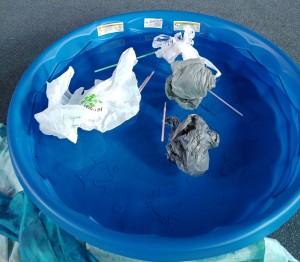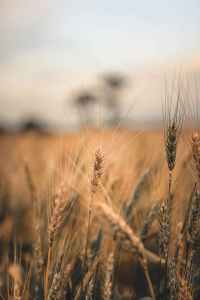
“In the beginning when God created the heavens and the earth, the earth was a formless void and darkness covered the face of the deep, while a wind from God swept over the face of the waters.” (Genesis 1)
The Schocken Bible offers the opening of Genesis this way: “at the beginning of God’s creating of the heavens and the earth, when the earth was wild and waste, darkness over the face of Ocean, breath of God hovering over the face of the waters…”
There are two things is these verses which are especially important for us in this this time.
The first: the distinction between “in the beginning when God created…” and “at the beginning of God’s creating…”
“In the beginning when God created,” implies that nothing existed before a certain point in time. It implies that God got busy creating, and according to the story, worked for six days, turned it over to humans for safekeeping and then God rested. God’s work was done as soon as creation came into being. It sounds like a onetime event.
“At the beginning of God’s creating” implies that this creation story is merely the beginning of God’s creative process. A New Creed affirms that we “believe in God who has created and is creating.” God’s creating is an on-going process.
The second thing that’s important for us in these two verses the difference between a formless void and wild and waste. Formless void implies that there was absolutely nothing and that God called creation into being out of nothingness.
Wild and waste implies that matter existed. It just wasn’t in any organized, recognizable form. The Inclusive Bible phrases it as “chaos and emptiness.” The Jewish study Bible has this to say about chaos. “To modern people, the opposite of the created order is ‘nothing,’ that is, a vacuum. To the ancients, the opposite of the created order …. was an active, malevolent force we can best term ‘chaos.’”
So, in the ancient tradition, there was a belief that what existed before creation as we know it was untamed, unorganized, chaotic matter. Chaos theology (Dr. Sjoerd L. Bonting) offers this idea bringing science and theology together: there was a big bang which created chaos—energy and disorganized matter which God used to create the universe.
God used what already existed to begin creation. It seems everything is neat and orderly. God set everything in motion, and it should all work perfectly. Except that chaos theology goes on to suggest that there was a tiny bit of chaos left over that even God couldn’t control.
If there’s a bit of chaos left in the universe, it suggests that even God could be surprised and unprepared for what will happen next. We can see and identify chaos all around us—random accidents, miracle recoveries, new viruses, floods, hurricanes, earthquakes, drought…all things that are possible—both good and bad—but in the realm of unlikely or inexplicable. How do we explain one person gets sick and dies, someone else recovers perfectly? How do we explain someone who was supposed to be on the Titanic, for example, and changed their plans at the last minute? We might say these are the bits of chaos still left in the universe.
Our faith affirms that God is still at work using the chaos that already existed to create and re-create.
What can we learn about present circumstances from this story?
Chaos has always existed, and it creates the energy and opportunity for creation and re-creation. If we say we are living in a time of chaos, we might ask: what are the opportunities to create something new from this energy? What is currently in need of being re-created?
We can’t plan for every eventuality. We can’t know what will happen next. In the midst of what feels like an uncertain time it might be tempting to try and control everything. The creation story reminds us that God can’t control every bit of chaos. If God can’t control every bit of chaos, why should we expect to control the chaos we experience?
Going back to school at this time is fraught with all sorts of unknowns. Chaos and the uncertainty attached to it is neither good nor bad. It simply is. Can we use the chaos to create new routines or patterns that are life-giving? Can we use the chaos to think more carefully about our choices?
When God uses the chaos to create, God sees that it is good. Can we see what comes out of the chaos as something good rather than something to be afraid or anxious about? If we look at what we might consider destructive chaos, we might be able to see God creating something good. If we think about covid, we can see the ways in which people are helping their neighbours who are isolating for various reasons. If we think about Black Lives Matter, we can see the ways in which people are finally beginning to see the systemic racism and work for change. Our reconciliation work in Canada offers an opportunity for new relationships, more understanding and changes in systems that have been destructive for many Indigenous people. These are good things that come out of the energy of chaos.
I encourage us to embrace the chaos that exists around us knowing that God is present and the chaos can actually support us in creating and re-creating the world around us.
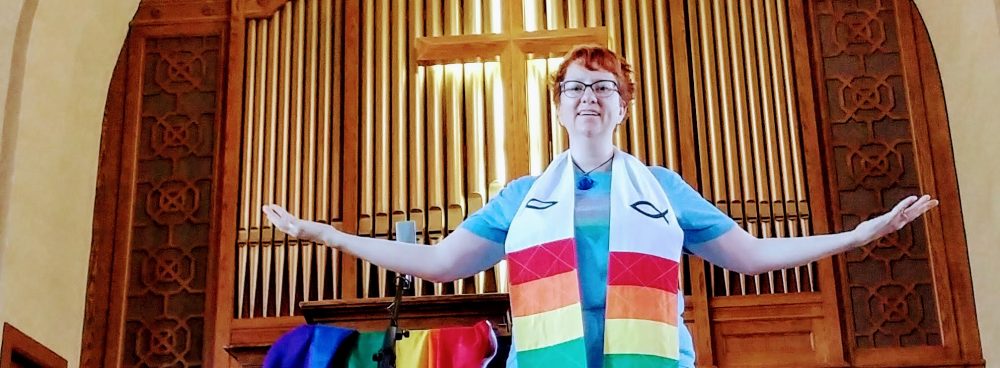
 Season of Creation at
Season of Creation at  September 22 was Cosmos Sunday at
September 22 was Cosmos Sunday at 
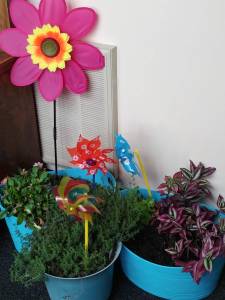 On September 15, we celebrated Storm Sunday as the second Sunday of Season of Creation. As people arrived for worship they were given a raindrop made out of wax crayon melted between wax paper. Instructions can be found
On September 15, we celebrated Storm Sunday as the second Sunday of Season of Creation. As people arrived for worship they were given a raindrop made out of wax crayon melted between wax paper. Instructions can be found  To get us thinking about storms I used a clip of
To get us thinking about storms I used a clip of 
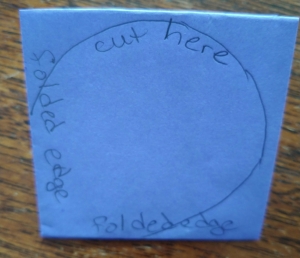 As each person arrived, they were given a paper flower. Thanks to the work crew for all their cutting! These are made by squaring a piece of coloured letter paper and cutting it into quarters. These smaller squares are folded into quarters. The unfolded edges are trimmed as shown.
As each person arrived, they were given a paper flower. Thanks to the work crew for all their cutting! These are made by squaring a piece of coloured letter paper and cutting it into quarters. These smaller squares are folded into quarters. The unfolded edges are trimmed as shown.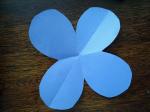
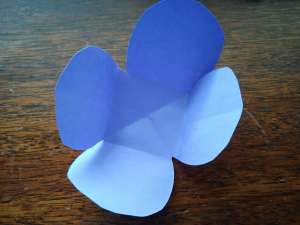 Then you fold up the petals to create a square bottom and the flowers float.
Then you fold up the petals to create a square bottom and the flowers float.